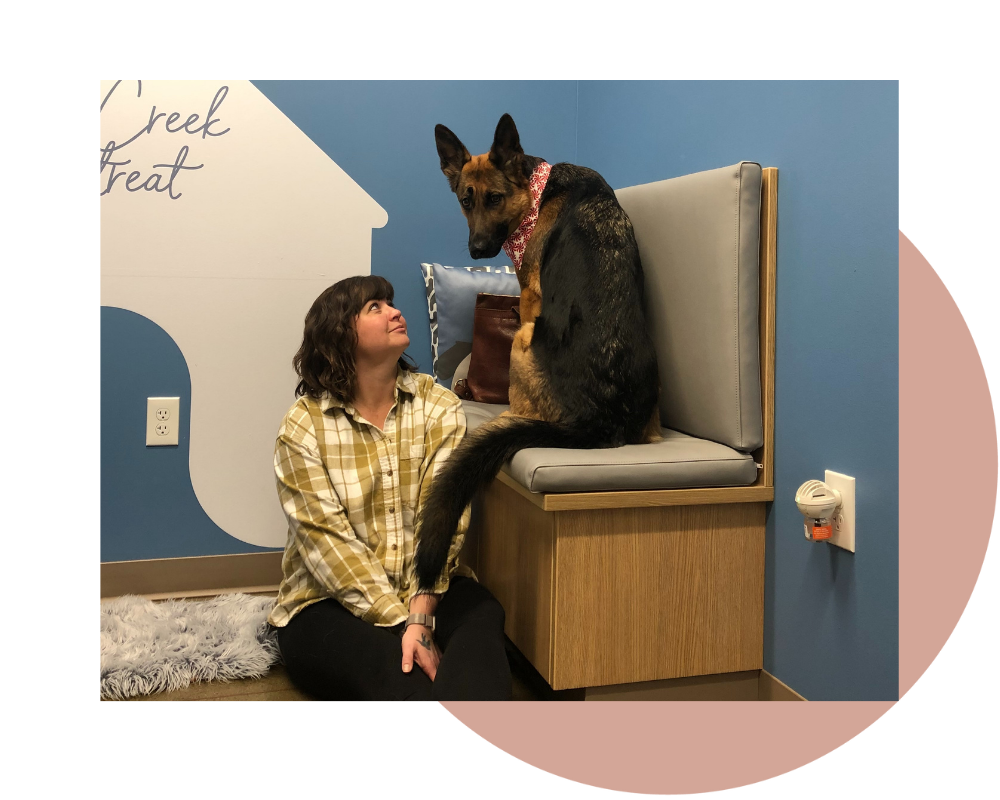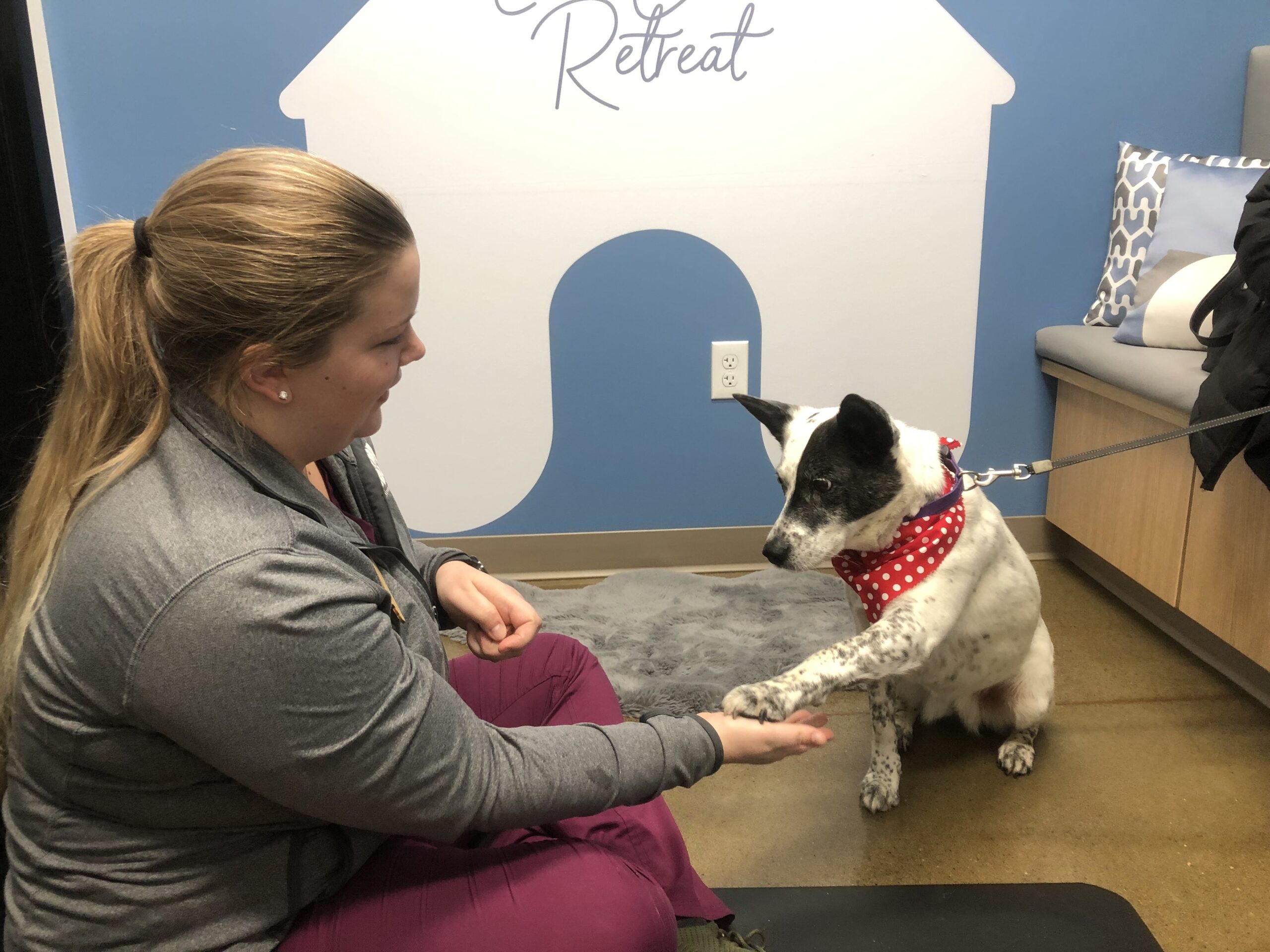Dog Behavior

Common Behavior Issues
Separation Anxiety
What is separation anxiety?
Separation anxiety is characterized by dogs that display signs of anxiety when they do not have access to family members. These signs are usually seen when the owner is away from home, but can also be seen when the owner is in another room or steps outside.
What are some signs my pet might have separation anxiety?
- Vocalizing – barking or whining
- Pacing
- Excessive panting
- Destructive behaviors
- House soiling
- Trying to escape confinement in a crate or room
- Self-mutilation
Reactivity to new people and/or dogs
One common canine behavioral issue is fear of unfamiliar people. Some dogs are sensitive to human behaviors and appearances and may react negatively to some of them. These include a larger body, a loud, booming tone of voice, facial hair, costumes, or a hat shading the face. Dogs can interpret abrupt movements, roughhousing, or hovering over them for petting as confusing and intimidating. This fear could be caused by genetics, a lack of socialization as a puppy, or previous negative experiences. Your dog can be slowly exposed to people they are afraid of and learn to create positive associations through positive reinforcement training. If your dog’s fear is escalating to aggression, please seek professional help.
Another common reported behavioral issue is leash reactivity or dog reactivity. This can be caused by a wide variety of causes, including genetics, hormones, lack of socialization, previous negative experiences, or anxiety. If there is a safety concern, please do not walk your dog until you receive professional help. Otherwise, please walk your dog where he will not encounter other dogs until you receive professional help – trying to “socialize” your dog with other dogs will only cause more anxiety if there is already a fear.
If there is a safety concern for you, your dog, other animals, or other people, avoid walking your dog until you have received professional assistance.
Resource Guarding
Resource guarding is a common behavior problem in dogs because it stems from normal evolutionary behavior in dogs as resources are necessary for survival. It is defined as a dog using avoidance, threatening, or aggressive behaviors to retain control of food or other items in front of a person or other animal. These behaviors can range from freezing and hunching over preferred resources to aggression such as snapping and biting.
The utmost priority when managing resource guarding is safety, so please do not attempt training without the help of professional assistance.
Noise Phobia
A fear of loud or sudden noises is one of the most common behavioral issues that dogs experience. Their hearing is far more acute than ours, and loud noises such as the bangs and booms of thunder or fireworks can be very threatening, as from their point of view these noises are unexpected and unpredictable. Some dogs are also afraid of neighborhood noises such as trucks, planes, or beeps. A combination of medications and behavior modification can be very helpful in treating noise phobia.
How behavior appointments work at Latah Creek Animal Hospital:
Step One: Medication consultation with the doctor at Latah Creek Animal Hospital:
This is the “immediate” first step before a full consultation can be booked, to potentially start medications and discuss which of the below options may be best for you moving forward. You will be asked to fill out a brief survey prior to your appointment. One of the following options will then be discussed with you, and a personalized plan will be made for your pet.
Step Two: Personalized Consultation Plan
1. Full consultation with the doctor at Latah Creek Animal Hospital: Dr. Megan Bauer has a special interest in behavioral medicine. We offer behavior consultations to clients whose pets have mild to moderate behavioral issues. Severe or refractory behavioral issues may need to be referred to a board-certified veterinary behaviorist. This visit comprises a 1-hour initial behavioral visit to discuss behavioral concerns and review protocols for training and tools and medications needed to implement training. You will be asked to complete a comprehensive survey on your pet’s behavior before the appointment. You may also be asked to take pictures or videos of the behavior and environment.
2. Consultation with Veterinary Behaviorists: The closest board-certified veterinary behaviorist is Dr. Chris Pachel at Animal Behavior Clinic in Portland, Oregon. Please contact them to find out if teleconsultation is an option for your pet.
3. Working with local trainers: We do have some great local dog trainers here in Spokane, such as Diamonds in the Ruff and Love Hope Dogs. We also have a positive reinforcement trainer on-staff who can set up a behavioral modification plan for certain issues. We believe in positive re-enforcement training, and counter-conditioning as the vast majority of behavioral issues have an underlying anxiety component. This anxiety can often get worse when punishment or dominance is used. The benefit of doing the behavior consult in addition to training is that training is often more effective with anti-anxiety medications.

